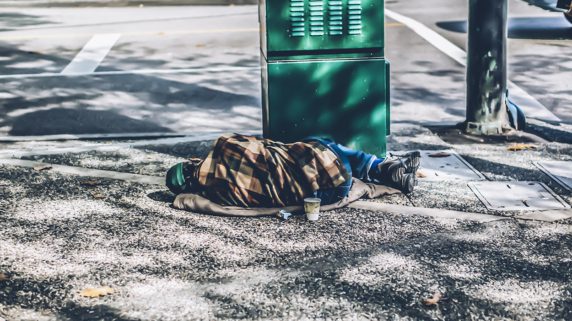The Government Just Took a Step in Loving People to Death
 James Whitford
James Whitford
Founder & CEO
Read more from James
Listen to this article:
As of September 1, if you were homeless, work requirements established in the 1996 Personal Responsibility and Work Opportunity Reconciliation Act no longer apply to you. They neither apply if you’re a veteran or have aged out of the foster care system and are under 24.
The federal government doesn’t believe that “personal responsibility and work opportunity” can help the homeless, veterans or foster care youth.
The phrase “loving people to death” is apt. It was used by a homeless woman in Portland, Oregon, last month, according to Kevin Dahlgren, who tweeted his interview beside the woman’s tent. “They feed you three meals a day. You don’t have to do s**t but stay in your tent or party,” she said.
Dahlgren, who works for a homeless service provider in Portland, said the woman he interviewed is not the only one claiming they’re being loved to death. And he’s right.
More than 230,000 people will sleep on the streets in America tonight, a number that has risen 35 percent in the last eight years, along with welfare spending, which has increased from $848 billion annually to $1.19 trillion, a 14 percent increase after considering inflation.
More welfare isn’t the answer. And neither is reducing welfare work requirements that might help people escape the dependency trap. But, unfortunately, the recently passed Fiscal Responsibility Act did just that.
Signed into law June 3 as a compromise deal to raise the debt ceiling, this law is less than “responsible” because it takes another step toward “loving people to death.” Although it increases the age for work requirements for able-bodied adults receiving SNAP benefits or food stamps, the Congressional Budget Office projects that the effects of exemptions for other groups will have an overall effect of increasing the food stamp rolls by 78,000 people, costing Americans an additional $2.1 billion. It’s more than an issue of cost, though. More than 70 percent of SNAP households already have no earned income, so increasing SNAP enrollment by removing work requirements is a step in the wrong direction for Americans needing work and the dignity it provides.
This kind of welfare expansion and other handouts often hurt the homeless more than help them. If you don’t believe me, take their word for it.
While visiting a homeless encampment in Huntsville, Alabama, three years ago, I met a couple beside their tent. Sitting outside their makeshift home, Shay and Wendy told me that community members should quit “dropping stuff off because it makes us lazy.” Shay concluded our conversation with, “I appreciate the compassion, but it just keeps us sitting on our butts.” I visited that homeless camp last month, and to my chagrin, Shay and Wendy were still there and not looking too good.
Maybe we really are loving people to death.
One businessman I spoke with recently in Portland described the decline in his city as a “doom-loop.” He doesn’t know what to do but is keenly aware that handouts and welfare are loving people to death. Loving with short-sighted, one-way charity condemns our homeless neighbors to a life on the streets that often ends in tragedy. Americans nationwide are witnessing that doom-loop to death in their urban centers — subsidized by ever-expanding welfare programs.
“We sell Obama phones for 50 bucks and then go get another one,” one person admitted regarding the federally subsidized cell phone program. “It’s easy to sell food stamps for 50 cents on the dollar, too,” another confessed.
These comments are from the unsheltered who are also unable or unwilling to join a work-based program, often because of addiction to hard drugs that often leads to severe mental illness or death.
As the founder of a homeless mission, I’ve learned that people in poverty need opportunity and a community that believes in them. I’ve cheered on countless people who once fell in the “marginalized” or “underserved” category celebrated leaving the margins and entering the mainstream. John, once a grisly, homeless meth-addict who stood on the street corners holding a cardboard sign, was cheered on to sobriety and independent housing; he is now working at a local hospital. Jocelyn lived in a cardboard box and feared giving up drugs and food stamps. But after leaving our mission, she went on to college, where she earned a master’s degree, and now lives a life free of drugs, independent of the government.
Many, like John and Jocelyn, once hopeless, now have hope and are contributors to society, utilizing their gifts and skills to serve others. And they are doing it free from poverty and welfare dependency.
The federal government may not believe in the value and potential of the most vulnerable among us, but I do. The Fiscal Responsibility Act and its inference that if you’re down and out, you have nothing to offer is offensive. I can only hope that the homeless, veterans and foster care youth will see it for what it is and say, “No thanks. I won’t be loved to death.”
This article was previously published by the DC Journal.

This article is just the tip of the iceberg for the practical resources available through the True Charity Network. Check out all of the ways the network can help you learn, connect, and influence here.
Already a member? Access your resources in the member portal.


